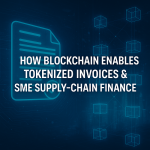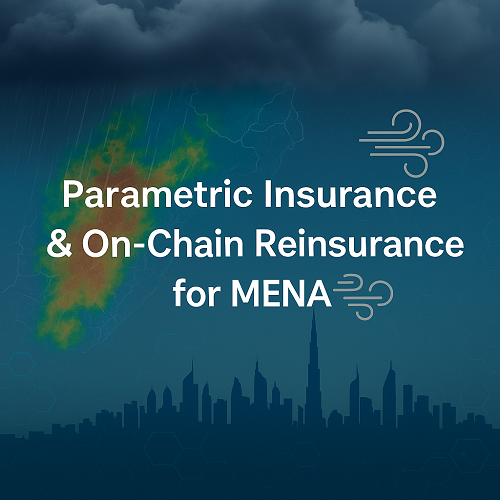Introduction
Parametric policies pay when a measurable trigger is met (e.g., rainfall above X mm), enabling fast, objective, auditable payouts. In the UAE—and across MENA—better data, stronger supervision, and programmable rails make parametrics a practical solution for climate, infrastructure, and cyber risks.
Why it matters now
- Rising hydro-climate volatility and infrastructure exposure
- The need for instant liquidity for SMEs and municipalities
- Growing comfort with on-chain automation and transparent settlement
What Parametric Insurance Is—And Why MENA Needs It
Parametric differs from indemnity: you don’t adjust losses—you check the trigger and pay. That speed and predictability fit the UAE’s growth profile.
Priority Use Cases

- Flash flood & rainfall for urban assets and fleets
- Wind / sand-dust for events and solar O&M
- Seismic / surge for coastal and logistics assets
- Cyber downtime for e-commerce and hospitality
- Renewables yield for solar/wind performance
Regulatory Landscape in the UAE (CBUAE, DIFC/DFSA)
(Choose the right jurisdiction and map your product accordingly.)
Onshore UAE (CBUAE)
The Central Bank of the UAE supervises insurance; align licensing, solvency, conduct, and marketing with its guidance. See CBUAE Insurance Guidelines.
DIFC (DFSA)
In the DIFC, the DFSA regulates (re)insurers, MGAs, and intermediaries. A good reference point is the DFSA May 2025 amendments to the Rulebook—evidence of an active rulemaking cadence.
Architecture: From Sensor to Smart Contract to Settlement
A durable parametric stack in the UAE should be data-first and oracle-secure.
Data Ingestion
Weather stations, radar mosaics, satellite rainfall, hydrology gauges, seismic arrays, cloud uptime logs, or industrial IoT—whichever best reflects the peril.
Oracles
Deliver off-chain readings to the chain in a tamper-resistant way. See Chainlink data feeds as a widely used approach for authenticated parametric inputs.
Smart Contracts & Treasury
Encode the trigger and payout schedule; wire settlement to AED bank rails or on-chain stable value. Emit a clear, auditable state change when the trigger is met.
Triggers & Data: Picking the Right Signal
Minimize basis risk by aligning the trigger to operational pain.
Examples
- Urban flash flood: 6/12/24-hour rainfall or gauge-based water level
- Wind / dust: sustained wind (knots) and PM thresholds (μg/m³)
- Cyber downtime: provider outage minutes in the local region
- Renewables: irradiance or wind lull against expected yield
Pricing the Trigger: Reducing Basis Risk
Back-test 10–15 years of local data; use blended sources (satellite + radar + ground truth); tighten polygons; and tier payouts (bands) rather than a single cliff.
Practical Checklist
- Granularity (polygon + station density)
- Data redundancy and deterministic tie-breakers
- Buyer co-design to mirror real cost-of-disruption
Distribution & UX: From Quote to Instant Payout
Parametrics win when buyers understand the promise and see the payout fast.
Quote & Bind
- Plain-language trigger and data source
- Polygon map + payout table + scenarios
- Bilingual receipts (Arabic/English) with a contract/hash reference
Settlement UX
- On-chain: show the transaction hash and timestamp
- Off-chain: AED reference, bank SLA, and a short dispute window
On-Chain Reinsurance: Pools, Treaties, and Syndication
On-chain structures make capacity transparent and fast.
What to Syndicate On-chain
- Quota share / stop-loss pools with real-time exposure views
- Event-linked notes that settle programmatically after oracle confirmation
- Retro layers that clear quickly after multi-region storms
Case Snapshot: UAE Cat Parametric with Global Re Support
Market reporting in May 2025 highlighted Munich Re backing a UAE parametric catastrophe product for Al Wathba Insurance—a sign of reinsurer appetite for well-designed triggers and verified third-party data. Read coverage by The Insurer.
Why That Matters
- Validates demand for fast, objective payouts
- Demonstrates reinsurance capacity for UAE-specific perils
Risks & Challenges
Tackle these early to protect credibility.

Regulatory Mapping
Map entity, product, data vendors, and marketing to CBUAE or DFSA (as applicable). Keep disclosures bilingual and current.
Data/Oracle Risk
Specify redundancies and SLAs; use signed, high-availability oracle feeds.
Model Drift
Climate non-stationarity can break old thresholds—review annually.
Liquidity Clustering
If many payouts trigger at once (city-wide rainfall), ensure your reinsurance or pool capital clears fast.
Common Mistakes to Avoid
- Selling parametrics like indemnity (don’t—explain trigger ≠ loss adjuster)
- Hiding the trigger or data vendor hierarchy
- Depending on one data source with no deterministic fallback
- Over-broad exclusions that undercut automation
- Shipping English-only UX in the UAE
Fees & Charges to Budget
- Data vendors: station installs, satellite/radar licenses
- Oracles & infra: feed requests, node SLAs, on-chain transactions
- Audits: smart contracts (initial + annual)
- Compliance: authorization pathway, product filings, marketing approvals
- (Re)insurance ops: brokerage, bordereaux automation, dispute handling
90-Day Pilot Plan (UAE Insurer / MGA)
Days:
0–15: pick peril + polygon; lock primary/secondary data; define tiers.
16–45: build oracle → contract; complete audit; draft bilingual docs; prep reinsurance term sheet.
46–75: sandbox with hindcasts; bind first policies; fund payout wallet.
76–90: embed distribution; launch; stress test during a live event; refine.
Outlook 2025–2027 for MENA
Parametrics will scale via better data and on-chain capacity. Expect broader discussion at regional forums (for example, DWIC 2025 spotlighted parametrics’ role in closing protection gaps—see Global Reinsurance coverage). As supervision matures, standardized data schemas and oracle SLAs will further reduce friction for parametric insurance UAE programs.
What to Watch
- Expansion of municipal/SME micro-parametrics
- More event-linked notes and transparent re pools
- Tighter integration with renewables and urban flood resilience
Final Thoughts
Parametrics aren’t a cure-all—but for clearly measurable perils they’re the most honest and fastest promise in insurance: if X happens, we pay Y. In the parametric insurance UAE market, the ingredients now exist—reliable datasets, oracle security Dubai, clearer supervision, and reinsurer appetite—to deliver liquidity within hours and scale capacity via on-chain reinsurance.
The winning approach is pragmatic: start with one peril in one polygon, publish the trigger and data hierarchy in plain language, and keep receipts bilingual (Arabic/English) with an auditable on-chain/off-chain trail. Align early with regulators and reinsurers, and make fallback logic (secondary data, tie-breakers, challenge window) explicit so automation never feels opaque.
FAQs
1) How does parametric differ from indemnity?
No adjuster: if the trigger is met, the policy pays—fast and objective.
2) Who regulates parametric insurance in the UAE?
Onshore: CBUAE. DIFC: DFSA. Choose the right jurisdiction and align licensing, filings, and conduct.
3) How do smart contracts “know” to pay?
Through oracles that deliver authenticated off-chain data (e.g., weather, uptime) onto the chain.
4) What perils work best?
Flash flood, wind/sand, surge, seismic parameters, renewables yield, and cloud downtime—wherever an auditable dataset exists.
5) What is the basic risk?
When triggered ≠ loss. Reduce by tightening polygons, blending data, and using tiered payouts.
6) Is on-chain reinsurance real?
Yes—quota share/stop-loss pools and event-linked notes can settle programmatically after oracle confirmations.
7) How fast are payouts?
Often minutes to hours once final readings post and any short dispute window closes.
8) What do buyers need to see in quotes?
Trigger, data source hierarchy, polygon map, payout table, sample scenarios, and bilingual receipts.
9) Do parametrics work for SMEs?
Yes. Micro-covers embedded in platforms can close protection gaps efficiently.
10) How do we start?
Run a single-peril pilot in one polygon, then expand with on-chain re support.
Work with Websima
Ready to ship parametric insurance UAE products that pay fast—and scale with on-chain reinsurance? Websima helps insurers, MGAs, and reinsurers turn triggers into trusted payouts: we co-design the trigger, wire credible data via oracles, audit the smart contracts, and stand up transparent re/pool capacity.
What you’ll get in your first sprint
- Trigger + data blueprint (primary/secondary sources, fallback logic)
- Oracle + smart-contract architecture with audit checklist
- Compliance mapping (CBUAE/DIFC-DFSA) and bilingual UX copy
- Reinsurance options (quota share/stop-loss) with real-time telemetry
Let’s talk:
Contact Websima to book a free 20-minute discovery call and get a tailored pilot plan and timeline. We typically respond within one business day.





